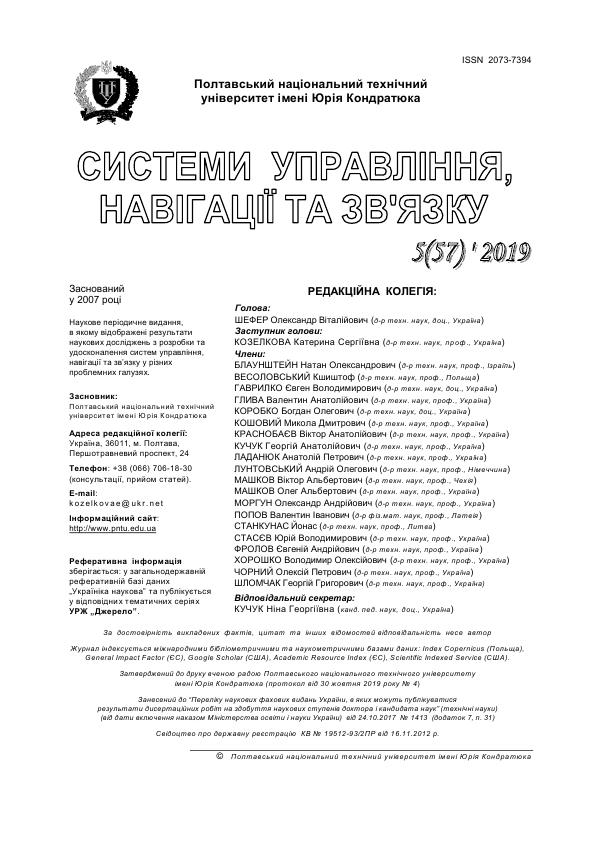ПАРАМЕТРИЧНА ІДЕНТИФІКАЦІЯ ДІАБЕТИЧНИХ СТАНІВ ПРИ ВИКОРИСТАННІ ПОЛІНОМІАЛЬНИХ МОДЕЛЕЙ ДИНАМІКИ ГЛІКЕМІЇ
DOI:
https://doi.org/10.26906/SUNZ.2019.5.088Ключові слова:
діабетичний стан, динаміка глікемії, параметрична ідентифікація, поліноміальна модель, середній ризик, алгоритм ідентифікаціїАнотація
Предметом дослідження є елементи аналітичного і структурного синтезу процедури ідентифікації моделі динаміки глікемії за критерієм максимальної правдоподібності. Метою роботи є зменшення ризиків ідентифікації діабетичних станів при використанні поліноміальних моделей динаміки глікемії. Завдання. На основі результатів глюкозотолерантного тестування дослідити можливості параметричного розпізнавання діабетичних станів, коли динаміка рівня глюкози апроксимується поліноміальною моделлю будь-якого порядку. Використати аналітичний вираз для мінімуму середнього ризику для структурного синтезу процедури ідентифікації виду діабету. Підтвердити ефективність використання отриманої структурної схеми процедури ідентифікації моделі динаміки глікемії при глюкозотолерантному тестуванні. Висновки. Розроблено блок-схему з адаптивною (по відношенню до кількості ідентифікованих глікемічних моделей) структурою і відповідна їй комп’ютеризована система багатосторонньої ідентифікації моделей динаміки глікемії за двома глюкозотолерантними тестами. Доведено можливість підвищення достовірності діагностики при використанні запропонованого методу, у порівнянні зі стандартним від значення 0,972 до 0,974 (обсяг навчальної вибірки N = 60).Завантаження
Посилання
Сахарный диабет: Доклад исследовательской группы. сер. техн. докл. ВОЗ. М. Мед. 1987. 125 с.
Лапта С.С. Методы повышения диагностической эффективности глюкозотолерантных тестов (на основе математического моделирования динамики гликемии): Дис. канд. техн. наук: 05.11.17 / ХНУРЭ. – Х., 2004. – 220 с.
Сокол Є.І. Підвищення ефективності глюкозотолерантних тестів при використанні поліноміальних моделей динаміки глікемії / Є.І. Сокол, П.Ф. Щапов, О.В. Чмихова // Сучасні інформаційні системи. Т. 3, № 3. Харків, 2019. С. 138-141.
Левин Б.Р. Теоретические основы статистической радиотехники. Кн. 2 / Б.Р. Левин – М.: Сов. радио, 1975. – 392 с.
Айвазян С.А. Прикладная статистика: основы моделирования и первичная обработка данных / С.А. Айвазян, И.С. Енюков, Л.Д. Мешалкин. – М.: Финансы и статистика, 1983. – 471 с.
Дуда Р. Распознавание образов и анализ сцен / Р. Дуда, П.Харт. – М.: Мир, 1976. – 512 с.
Зыбов В.Н. Моделирование функции преобразования первичного преобразователя в задачах многофакторных измерений / В.Н. Зыбов // Измерительная техника. – 2006. - № 4. – С. 26-31.
Джонсон Н. Статистика и планирование эксперимента в технике и науке: Методы планирования эксперимента / Н. Джонсон, Ф. Лион; пер. с англ. – М.: Мир, 1981. – 520 с.
Раудис Ш. Ограниченность выборки в задачах классификации / Ш. Раудис // Статистические проблемы управления. – Вильнюс. – 1976. – Вып. 18. – С. 1-185.
Щапов П.Ф. Повышение достоверности контроля и диагностики объектов в условиях неопределённости: монография / П.Ф. Щапов, О.Г. Аврунин. – Х.: ХНАДУ, 2011. – 191 с.




